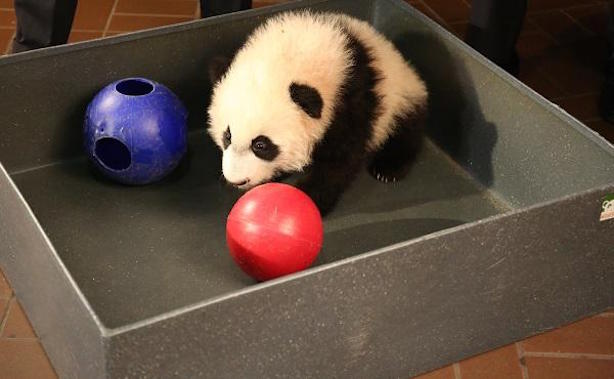Chubby Panda Cub 'Bei Bei' Learns to Stare at Tennis Balls

This story was updated June 1 at 6:10 p.m. EDT.
The National Zoo's youngest (and chubbiest) panda cub is learning how to touch a tennis ball with his little black nose, zookeepers say.
But it's not a ploy to sharpen his tennis game. Rather, zookeepers are training panda cub Bei Bei (BAY-BAY) to look at a tennis ball so that they can later use the ball as a signal to have the bear stand still for medical inspections, such as blood pressure checks and ultrasounds, said Laurie Thompson, a giant-panda biologist at the Smithsonian National Zoo in Washington, D.C.
"He's still kind of young and doesn't have a large attention span," Thompson told Live Science, so they only train him in 5- to 10-minute increments. By rewarding him with his favorite snack (cooked sweet potatoes), zookeepers hope to eventually train Bei Bei to sit, lie down and show his paws, she said. [What a Precious Bei Bei! Panda Cub Grows Up (Photos)]
The almost 9-month-old cub was born at the National Zoo on Aug. 22, 2015. In fact, Bei Bei (which means "precious treasure" in Mandarin) had a fraternal twin brother. But the brother, who was never named, lived only a few days. The cub died on Aug. 26, after he aspirated fluid and developed pneumonia, Thompson said.
Giant pandas (Ailuropoda melanoleuca) are classified as endangered, with only 1,000 to 2,000 mature individuals left in the wild, according to the International Union for Conservation of Nature. Zookeepers did their best to keep Bei Bei healthy after his brother died. Their efforts, combined with those of panda mother Mei Xiang (may-SHONG) paid off.
Now, at 46.5 lbs. (22 kilograms), Bei Bei is the roundest panda cub the zoo has ever seen. His big sister Bao Bao (born in 2013) and older brother Tai Shan (born in 2005) weren't quite as chubby in their youth, Thompson said.
Sign up for the Live Science daily newsletter now
Get the world’s most fascinating discoveries delivered straight to your inbox.
Between training and exploring the panda enclosure at the zoo, Bei Bei has been busy. He made his public debut and tried his first bamboo in January. He even successfully climbed a tree during his second outing in the zoo yard, although his mom helped him a bit. A zookeeper captured the adventure on video.
In the wild, panda cubs often climb trees as a way to avoid predators, Thompson said. Bei Bei often sleeps in trees now, and he's taken a few tumbles, but from not terribly high places, she said.
The cub also continues to play with Mei Xiang. "It's pretty rough and tumble," Thompson said. "We've had people be concerned that she's being too rough with him."
But Bei Bei is big and sturdy for his age, and he would let Mei Xiang know if he couldn't handle it, she said.
When he's not practicing touching his nose to tennis balls, climbing or sleeping, the furry cub can be spotted eating bamboo or any of a number of treats, including apples, soy-based biscuits and cooked sweet potatoes, Thompson said. [Baby Panda Photos: See a Cub Growing Up]
"He's a sweetheart," she said. "We all really like him. He's got a good personality."
Just like his brother Tai Shan, who now lives in China, Bei Bei (and Bao Bao, for that matter) will be transferred to the panda motherland when he turns 4 years old.
Until then, visitors can see him at the National Zoo, Thompson said.
In addition to Bei Bei, Bao Bao and Mei Xiang, visitors can see male panda Tian Tian. There are also pandas at the San Diego Zoo, Memphis Zoo and Zoo Atlanta, all of which are on loan from China.
Editor's Note: Live Science has updated the photo to show Bei Bei. The previous photo showed Bao Bao, his older sister, eating a frozen cake.
Follow Laura Geggel on Twitter @LauraGeggel. Follow Live Science @livescience, Facebook & Google+. Original article on Live Science.

Laura is the archaeology and Life's Little Mysteries editor at Live Science. She also reports on general science, including paleontology. Her work has appeared in The New York Times, Scholastic, Popular Science and Spectrum, a site on autism research. She has won multiple awards from the Society of Professional Journalists and the Washington Newspaper Publishers Association for her reporting at a weekly newspaper near Seattle. Laura holds a bachelor's degree in English literature and psychology from Washington University in St. Louis and a master's degree in science writing from NYU.









